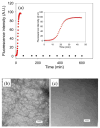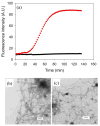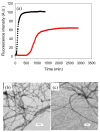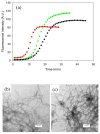Amyloid formation in heterogeneous environments: islet amyloid polypeptide glycosaminoglycan interactions
- PMID: 23154166
- PMCID: PMC3753189
- DOI: 10.1016/j.jmb.2012.11.003
Amyloid formation in heterogeneous environments: islet amyloid polypeptide glycosaminoglycan interactions
Abstract
Amyloid formation plays an important role in a broad range of diseases, and the search for amyloid inhibitors is an active area of research. Amyloid formation takes places in a heterogeneous environment in vivo with the potential for interactions with membranes and with components of the extracellular matrix. Naturally occurring amyloid deposits are associated with sulfated proteoglycans and other factors. However, the vast majority of in vitro assays of amyloid formation and amyloid inhibition are conducted in homogeneous solution where the potential for interactions with membranes or sulfated proteoglycans is lacking and it is possible that different results may be obtained in heterogeneous environments. We show that variants of islet amyloid polypeptide (IAPP), which are non-amyloidogenic in homogeneous solution, can be readily induced to form amyloid in the presence of glycosaminoglycans (GAGs). GAGs are found to be more effective than anionic lipid vesicles at inducing amyloid formation on a per-charge basis. Several known inhibitors of IAPP amyloid formation are shown to be less effective in the presence of GAGs.
Copyright © 2012. Published by Elsevier Ltd.
Figures












Similar articles
-
Cell surface glycosaminoglycans exacerbate plasma membrane perturbation induced by the islet amyloid polypeptide.FASEB J. 2021 Feb;35(2):e21306. doi: 10.1096/fj.202001845R. FASEB J. 2021. PMID: 33475205
-
New insights into the roles of sulfated glycosaminoglycans in islet amyloid polypeptide amyloidogenesis and cytotoxicity.Biopolymers. 2013 Nov;100(6):645-55. doi: 10.1002/bip.22243. Biopolymers. 2013. PMID: 23526456
-
The ability of insulin to inhibit the formation of amyloid by pro-islet amyloid polypeptide processing intermediates is significantly reduced in the presence of sulfated glycosaminoglycans.Biochemistry. 2014 Apr 29;53(16):2605-14. doi: 10.1021/bi4015488. Epub 2014 Apr 18. Biochemistry. 2014. PMID: 24654599 Free PMC article.
-
Aggregation of islet amyloid polypeptide: from physical chemistry to cell biology.Curr Opin Struct Biol. 2013 Feb;23(1):82-9. doi: 10.1016/j.sbi.2012.11.003. Epub 2012 Dec 22. Curr Opin Struct Biol. 2013. PMID: 23266002 Free PMC article. Review.
-
A mechanistic approach for islet amyloid polypeptide aggregation to develop anti-amyloidogenic agents for type-2 diabetes.Biochimie. 2011 May;93(5):793-805. doi: 10.1016/j.biochi.2010.12.012. Epub 2011 Jan 5. Biochimie. 2011. PMID: 21215287 Review.
Cited by
-
Epigallocatechin-3-gallate remodels apolipoprotein A-I amyloid fibrils into soluble oligomers in the presence of heparin.J Biol Chem. 2018 Aug 17;293(33):12877-12893. doi: 10.1074/jbc.RA118.002038. Epub 2018 May 31. J Biol Chem. 2018. PMID: 29853648 Free PMC article.
-
Heparan sulfates facilitate harmless amyloidogenic fibril formation interacting with elastin-like peptides.Sci Rep. 2018 Feb 15;8(1):3115. doi: 10.1038/s41598-018-21472-0. Sci Rep. 2018. PMID: 29449596 Free PMC article.
-
Sulfate anion delays the self-assembly of human insulin by modifying the aggregation pathway.Biophys J. 2014 Jul 1;107(1):197-207. doi: 10.1016/j.bpj.2014.05.030. Biophys J. 2014. PMID: 24988354 Free PMC article.
-
Mechanistic Contributions of Biological Cofactors in Islet Amyloid Polypeptide Amyloidogenesis.J Diabetes Res. 2015;2015:515307. doi: 10.1155/2015/515307. Epub 2015 Oct 20. J Diabetes Res. 2015. PMID: 26576436 Free PMC article. Review.
-
Extracellular vesicles from human pancreatic islets suppress human islet amyloid polypeptide amyloid formation.Proc Natl Acad Sci U S A. 2017 Oct 17;114(42):11127-11132. doi: 10.1073/pnas.1711389114. Epub 2017 Oct 2. Proc Natl Acad Sci U S A. 2017. PMID: 28973954 Free PMC article.
References
-
- Vendruscolo M, Zurdo J, MacPhee CE, Dobson CM. Protein folding and misfolding: a paradigm of self-assembly and regulation in complex biological systems. Philos Trans R Soc Lond Ser A-Math Phys Eng Sci. 2003;361:1205–1222. - PubMed
-
- Sipe JD. Amyloidosis. Crit Rev Clin Lab Sci. 1994;31:325–354. - PubMed
-
- Kirkitadze MD, Bitan G, Teplow DB. Paradigm shifts in Alzheimer’s disease and other neuro degenerative disorders: The emerging role of oligomeric assemblies. J Neurosci Res. 2002;69:567–577. - PubMed
-
- Lorenzo A, Razzaboni B, Weir GC, Yankner BA. Pancreatic islet cell toxicity of amylin associated with type-2 diabetes mellitus. Nature. 1994;368:756–760. - PubMed
Publication types
MeSH terms
Substances
Grants and funding
LinkOut - more resources
Full Text Sources
Other Literature Sources

